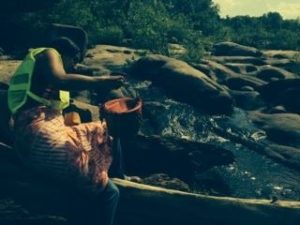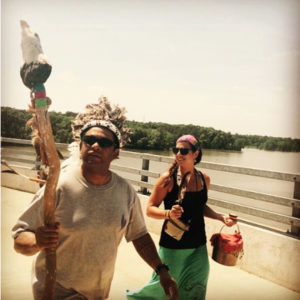
Pura Fe, Tuscarora Indian Nation, scrambles over the rockbed of Belle Isle in the James River Park System
Without water on this planet, life would not exist. We all know this undeniable fact, but how often do you think about your personal, day-to-day connection to the water? Sharon Day and the Nibi Walkers are here to remind us that we must protect, pray, and love the water every single day. Nibi is the Ojibwe word for water, and Nibi Walks are Indigenous-led ceremonies in which walkers pray for the water with every step they take. In the spring of 2015, Sharon Day, an Ojibwe elder and the executive director of the Indigenous Peoples Task Force, brought this Ojibwe ceremony to the James River with assistance by the James River Association.
The James River is often referred to as America’s Founding River. The first successful English settlement was established on the shores of the Powhatan River, renamed the James by its English settlers in 1607. For Indigenous people of this continent, the “founding of America” meant the invasion of their homeland and the near destruction of their way of life. For African people, their arrival on the James meant a new life, and unfortunately for most, that meant an enslaved life. Looking back over the past 400 years, there is a critical need for both cultural and environmental healing. For these reasons, this particular ceremony was named the James River Unity Walk to honor the struggles of our ancestors and to positively bring all of us together for the future of the James River.

Greg Stephenson, Meherrin Nation, and Beth Roach, Nottoway Indian Tribe of Virginia cross over the Chickahominy River. In the Nottoway dialect of the Iroquoian language group, we say “auwa ike auwanhe” for “water is life.”
The James River Unity Walk started at the headwaters of the river in Iron Gate. It took 11 days to reach the mouth of the river at Fort Monroe in Hampton. Nibi Walk Protocols guide the walks, which include a prayer and a water song that start and end the walk each day. The water and the walkers do not stop moving once the daily walk begins. They do not backtrack. Walkers hand off the water every mile or so. Each time, they say to each other “Ni guh izhi chigay nibi onji.” In Ojibwe, these words mean “I’ll do it for the water.”
Look towards North Dakota at the Standing Rock Sioux Tribe and you see thousands of Indigenous people peacefully praying in protest of the Dakota Access Pipeline. This is the vision of the James River Unity Walk in action. Different nations and cultures coming together to protect the water for all. Ask any Indigenous person why they stand in solidarity with the Standing Rock Sioux, and they will respond “water is life”.
Ask yourself, what will you do for the water today?
Diane Stephenson, Hampton resident and a member of the Meherrin Nation, explains the importance of the James River Unity walk to the James River in this video.
